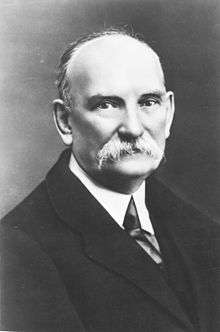Nikolai Semenovich Kurnakov
| Nikolaĭ Semenovich Kurnakov | |
|---|---|
 | |
| Born |
6 December 1860 Nolinsk, Russia |
| Died |
19 March 1941 (aged 80) Barvikha, USSR |
| Nationality | Russian |
| Known for | Kurnakov test |
| Scientific career | |
| Fields | Chemist |
| Wikimedia Commons has media related to Nikolai Semenovich Kurnakov. |

Nikolaĭ Semenovich Kurnakov (Russian: Никола́й Семёнович Курнако́в; 6 December 1860 – 19 March 1941) was a Russian chemist who was internationally recognized as the originator of physicochemical analysis and he was one of the principal founders of the platinum industry in the USSR. A chemical reaction that he pioneered, known as the Kurnakov test, is still used to differentiate cis from trans isomers of divalent platinum and is his best-known contribution to coordination chemistry.
Early life & career
Kurnakov was born in Nolinsk, Kirov Oblast. He attended a high school at Nizhny Novgorod and later studied at the mining institute in St. Petersburg. He published his first paper on alum crystallization and sodium thioantimoniate in 1882.[1] In the same year he graduated as a mining engineer.
During a trip to France, Germany and Austria Kurnakov studied salt manufacturing in several locations. The scientific work of this trip became his Ph.D. thesis, which he completed in 1884.
Career
He then worked for several years at the mining institute, mostly on the formation of salts and potash deposits and mining and benefication of salt and potash. In 1893, Kurnakov became professor of inorganic chemistry for his work on the reactions of cis- and trans- platinum complexes with thiourea, today known as the Kurnakov test.[2][3] In 1902 he became professor at the Saint Petersburg Polytechnic Institute, which he established together with Dmitri Mendeleev and Nikolai Aleksandrovich Menshutkin. He held the position until 1930.
In his later years, he focused his work on platinum chemistry and platinum production. He received several prizes, for example the Mendeleev Prize in 1936, the Order of the Red Banner of Labour in 1939 and the Stalin Prize in 1941. He was also awarded a Doctor honoris causa by University of Moscow in 1909. After the death of his wife in 1940 his health deteriorated and he died in a sanatorium in Barvikha on 19 March 1941.[3][4]
A mineral was named kurnakovite in his honor.[5][6]
References
- ↑ Kuznetsov, N. T. (2010). "N. S. Kurnakov's Contribution to Coordination Chemistry". Russian Journal of Inorganic Chemistry. 55 (11): 1777–1783. doi:10.1134/S0036023610110033.
- ↑ Kurnakow, N. (1894). "Ueber complexe Metallbasen; Erste Abhandlung". Journal für Praktische Chemie. 50: 481–507. doi:10.1002/prac.18940500144.
- 1 2 Kauffman, George B. (1983). "Nikolaĭ Semenovich Kurnakov, the reaction (1893) and the man (1860–1941) a ninety-year retrospective view". Polyhedron. 2 (9): 855–863. doi:10.1016/S0277-5387(00)81400-X.
- ↑ Kauffman, George B. (1982). "The Life and Work of Nikolai Semenovich Kurnakov". Platinum Metals Review. 26 (3): 129–133.
- ↑ Godlevsky, M. N. (1940). "Kurnakovite, a new Borate" (PDF). Comptes Rendus de l'Académie des Sciences de l'URSS. 28 (7): 638–640.
- ↑ Kuznetsov, N. T.; Novotortsev, V. M. (2010). "Nikolai Semenovich Kurnakov (to the 150th Anniversary of His Birthday)". Russian Journal of Inorganic Chemistry. 55 (11): 1668–1679. doi:10.1134/S0036023610110021.
Further reading
- Kong, Pi-Chang; Rochon, F.D. (1979). "cis- and trans-Platinum compounds of substituted pyrimidines and their products from thiourea in Kurnakov's reaction". Canadian Journal of Chemistry. 57 (5): 526–529. doi:10.1139/v79-086.
- Woollins, J (1983). "The detection of trace amounts of trans-Pt(NH3)2Cl2 in the presence of cis-Pt(NH3)2Cl2. A high performance liquid chromatographic application of Kurnakow's test". Polyhedron. 2 (3): 175–178. doi:10.1016/S0277-5387(00)83954-6.
- Solov'ev, Yu. I. (1961). "N. S. Kurnakov (on the centenary of his birth)". Journal of Structural Chemistry. 1 (4): 371–374. doi:10.1007/BF00745877.
- Tretyakov, Yu. D. (2010). "The role of N.S. Kurnakov in creating new generations of researchers". Russian Journal of Inorganic Chemistry. 55 (11): 1690–1693. doi:10.1134/S0036023610110069.
- Kuznetsov, N. T. (2010). "N. S. Kurnakov's contribution to coordination chemistry". Russian Journal of Inorganic Chemistry. 55 (11): 1680–1685. doi:10.1134/S0036023610110033.
- Kauffman, George B.; Beck, Alexander (1962). "Nikolai Semenovich Kurnakov". Journal of Chemical Education. 39: 44. Bibcode:1962JChEd..39...44K. doi:10.1021/ed039p44.
- Курнаков Н. С. Непрерывность химических превращений вещества // УФН. 1924. Т.4, Вып. 6. С.339–356 (Continuity of the chemical transformations of matter)
- Биография Н. С. Курнакова на сайте химфака МГУ (Scientist: Kurnakov, Nikolai Semenovich)
- Биография Н. С. Курнакова на кругосвете (Biography of N. S. Kurnakov)
- К 140-летию со дня рождения Н. С. Курнакова (To the 140 anniversary of his birth N. S. Kurnakov)
- Image of Nikolai Semenovich Kurnakov's grave